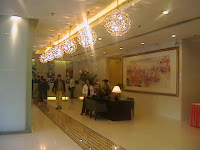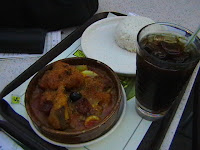 I really don't know where the Filipino connotation of "Lutong Macau" started. May I venture loosely into saying that we Filipinos usually use this phrase to mean that something is just made up, or that something was just cooked up, as in "cook the books." I now wonder if this is because Macau is principally a place you go to for gambling. Well, it's certainly the Las Vegas of the mainland China.
I really don't know where the Filipino connotation of "Lutong Macau" started. May I venture loosely into saying that we Filipinos usually use this phrase to mean that something is just made up, or that something was just cooked up, as in "cook the books." I now wonder if this is because Macau is principally a place you go to for gambling. Well, it's certainly the Las Vegas of the mainland China.Of course, when an opportunity came up to visit Macau (read: free trip), who's to say one will not jump at the chance? With so many people I know who have been to Macau telling me that it's a worthwhile destination, I said why not? Why not indeed. And so my mother and I packed our bags for both our birthday trip and some mother and daughter bonding.
We chose a centrally located hotel in the main island of Macau. While Hotel Beverly Plaza is a

four-star hotel, it had simple straightforward amenities. I thought at first I may have made a mistake in choosing this hotel. This is because I've already confirmed our reservations when I decided to check out the reviews on the place, and the people who previously stayed there gave mixed reactions. Lucky for us, the quality of service has improved for the better. Unlike what the previous guests have been saying, the hotel staff are friendlier and more helpful. Toiletries and coffee and tea courtesy trays are complete and clean. Their breakfast buffet still needs a bit of improvement though, but on the whole, they serve a satisfactory spread of Cantonese and Western breakfast. Being a Filipino though, I was looking for fried rice. I suppose it's not a Cantonese thing. However, I got to taste a more or less authentic Pancit Canton, Macau being a Chinese Canton region rather than Mandarin or Fookien Chinese.

For people like my mother and I who do not gamble, the best thing to do in Macau is to eat! So our first destination upon arrival was to go to The Venetian and find out what is all the fuss about the place. From central Macau, we boarded the ferry shuttle to reach the station, and from there, one can choose to which hotel you'd like to go. So many of the hotels in the area offer free shuttle service to the tourists as an incentive (and may I say temptation) for people to gamble in their casinos. Once, when Macau has not opened to the world yet, there was only one casino to go to - the Hotel Casino Lisboa, which is actually a few minutes' walk away from our hotel. But when the tourist industry boomed and Macau opened its doors for foreign investors in 2004, so many casinos were built and opened. There are presently 30 casinos in Macau right now, and for a region that is only 30 square kilometers in area, the statistics would be that there is one casino for every square kilometer. And because of the competition among these casinos, casino hopping becomes easier and more convenient since they all offer free shuttle services. That's free trade and competition for you.
So, we boarded the shuttle for The Venetian with much anticipation since we first saw the hotel

from the airport. It's a beautiful and grand structure, and upon going inside, one would notice how well-thought out the floor plans are, how opulent the interiors and how they were able to replicate much of the piazzas and interconnecting bridges of Venice. Nevertheless, I'm sorry to say that it is just a copy of a

beautiful place, and if you take out the layers, it is nothing but a hotel with a big shopping mall. It is, on the other hand, a self-contained little "city".
In search for dinner, we naturally thought of trying out traditional Macanese cuisine and what better way for a first timer to do that than to go to The Venetian's food court. Macanese cuisine is much influenced by the administration of Portugal of the region for 400 years. It reminded me of how Spain influenced Filipino cuisine as well. So what is traditional in eating Macau?
Like Filipinos, their favorite meats are pork and chicken, and they treat spaghetti the same way as rice. We saw spaghetti in tomato, hot, cheesy and curry sauces. We are likewise surprised at how big their individual servings were. Certainly, no one is supposed to go hungry in Macau.

For dinner, we chose Porto Exterior where I had the Portuguese Chicken, which is much like the Filipino chicken curry we have here, but theirs have chorizos and black olives in the mix. My mother had the Fish with Cheese Sauce, which are generous portions of fish fillets breaded and fried to a crunch placed on top of rice fried in mild spices and scrambled egg bits. We had to balance our meals off with poached bok choy from Pho Hoa (yes, not really a traditional Macanese dinner, I admit). However, my mother and I were really more than satisfied with such a heavy meal and decided to walk our meal off afterwards with a tumbler of fresh fruits to take home.

We thought that our dinner was just a peculiar thing there in The Venetian, but our future meals in Macau were about the same thing - generous portions of everything. Our other meals included trying out the 24-hour cantonese dimsum place right next to our hotel. I'm sorry that I couldn't write down the name since it was only written in Cantonese. While they have a menu written in English, the staff do not speak any, and I was reduced to just pointing out the items we liked in the list as written in English while the waitstaff would read the counterpart Cantonese. Service was quick too. The food is just like what you get in the usual Chinese restaurants here in Manila - and then some. I had the crispy breaded pork chop rice meal, which they served with hot steaming broth and steamed cabbage and turnips. My mother had the beef with peppers on rice. We had the vegetable dumplings as a side with the usual soy and chili garlic sauces, but I still prefer the Filipino way of injecting kalamansi juice in the sauce for some bite and balance.

Macau as a cultural destination can be done in one day or less. I appreciated the fact that the Macau Chinese preserved as much of their history as they possibly can. The Senado square, the Maa Gok Temple (where the goddess A-ma resides) and the Ruins of St. Paul (which is the symbol for Macau) are World Heritage sites that are really worth seeing in person. As Macau thrives much on their tourism industry, it is only but proper for one to respect how organized the government is in coordinating everything well. Considering that they are Chinese whose sense of culture is quite strong and deeply felt, they also do not forget and likewise respect and embrace their historical and foreign influences. It is truly a blending of east and west.






